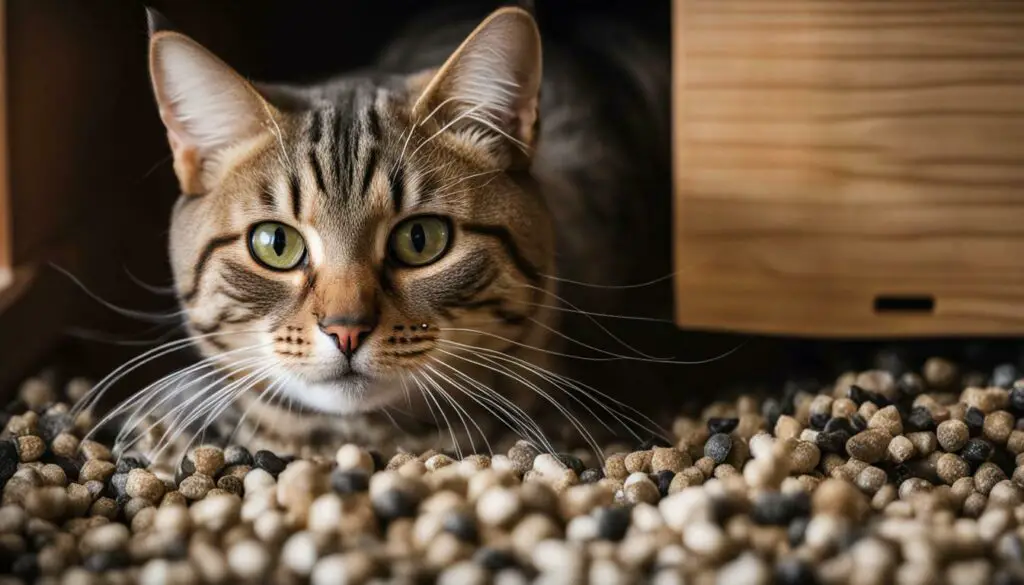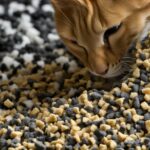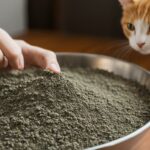Welcome to the comprehensive guide on how often to change cat litter. As a pet expert, I understand the importance of maintaining a clean litter box for your cat’s health and well-being. Whether you’re a new cat owner or looking to improve your litter box maintenance routine, this guide will provide you with all the information you need to ensure a fresh and comfortable environment for your feline friend.
Key Takeaways:
- Non-clumping litter should be changed at least once a week for one cat.
- Clumping litter can be changed every two weeks for one cat.
- Cleaning the litter box thoroughly with mild soap or detergent is important.
- Dispose of cat litter in regular household waste, unless using biodegradable litter.
- Prevent odor by keeping the litter box clean and avoiding strongly scented products.
Factors That Determine Cat Litter Changing Frequency
To determine the optimal frequency for changing cat litter, it’s important to consider a few key factors. These factors include the type of litter, the number of cats, and the number of litter trays available. By taking these factors into account, you can create a customized cat litter maintenance schedule that keeps your feline friend happy and your home fresh.
Type of Litter
The type of cat litter you choose can greatly impact how often it needs to be replaced. Non-clumping litter, for example, requires more frequent changing compared to clumping litter. Non-clumping litter should be replaced at least once a week for one cat, and more often if there are multiple cats using the same litter box.
On the other hand, clumping litter forms solid clumps that can be easily removed, allowing for less frequent changes. For one cat, clumping litter typically needs to be replaced every two weeks. However, if you notice any strong odors or the litter box becomes visibly dirty sooner, it may be time for an earlier change.
Number of Cats and Litter Trays
The number of cats you have and the number of litter trays available also play a role in determining how often you should change the litter. In general, it’s recommended to have one litter tray per cat, plus an extra one. This helps prevent overcrowding and reduces the likelihood of accidents outside the litter box. If you have multiple cats, you may need to change the litter more frequently to accommodate their needs and maintain cleanliness.
Litter Box Maintenance
In addition to regular litter changes, proper litter box maintenance is crucial for keeping a clean and odor-free environment. Each time you change the litter, be sure to thoroughly clean the litter box with mild soap or detergent. Rinse it well and dry it completely before adding fresh litter. Regular maintenance also includes scooping the litter box daily to remove waste and clumps, ensuring your cat always has a clean place to do their business.
By taking into account these factors and maintaining a regular cat litter maintenance schedule, you can create a clean and comfortable environment for your feline companion. Remember to observe your cat’s behavior and adjust the frequency of litter changes accordingly. With proper care, your cat will stay happy and your home will remain fresh.
Non-Clumping Litter: When to Replace
If you’re using non-clumping cat litter, it’s important to know when to replace it to ensure a hygienic litter box environment for your cat. Unlike clumping litter, which forms solid clumps that can be easily removed, non-clumping litter needs to be replaced more frequently to prevent odor buildup and maintain cleanliness. Changing the litter at the right time is essential for your cat’s comfort and well-being.
The recommended frequency for replacing non-clumping cat litter is at least once a week for a single cat. However, if you have multiple cats using the same litter box, more frequent changes may be necessary. The more cats using the litter box, the quicker the litter will become saturated with waste and odor.
Regularly scooping out solid waste and clumps will help extend the lifespan of non-clumping litter, but it’s important to remember that it still needs to be completely replaced on a weekly basis. This will ensure that your cat always has a clean and fresh litter box to use.
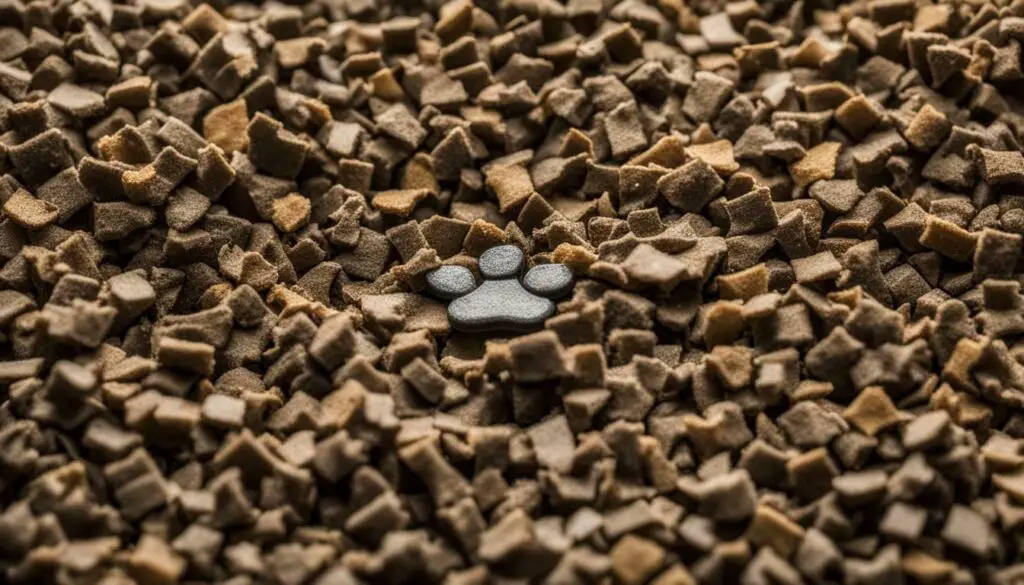
In summary, non-clumping cat litter should be replaced at least once a week to maintain a clean and hygienic litter box environment for your cat. More frequent changes may be necessary if you have multiple cats sharing the same litter box. By staying on top of litter replacement, you can ensure that your cat is comfortable and happy, and your home remains odor-free.
Non-Clumping Litter Maintenance Tips
Proper maintenance is key to ensuring a clean and comfortable litter box for your cat when using non-clumping litter. Regular cleaning and litter replacement are essential to prevent odor buildup and maintain a hygienic environment for your feline friend.
To start, scoop out solid waste from the litter box daily using a litter scoop or scoopable bags. This will help keep the litter box clean and minimize odor. Additionally, check the litter box for any clumps or wet spots and remove them promptly.
Once a week, completely empty the litter box and discard the used litter in a regular garbage bag. It’s important to thoroughly clean the litter box using mild soap or detergent and warm water. Avoid using strong-smelling cleaning products or harsh chemicals, as these can be off-putting to cats. Rinse the litter box thoroughly and make sure it’s completely dry before adding fresh litter.
When refilling the litter box, be sure to maintain a consistent depth of at least 2-3 inches of non-clumping litter. This provides enough material for absorption and odor control. Scatter the litter evenly and avoid clumping it together.
Remember, each cat is different, and some may require more frequent litter changes. Pay attention to any changes in your cat’s litter box behavior or signs of discomfort, as this may indicate the need for more frequent cleaning or litter replacement. By following these non-clumping litter maintenance tips, you can create a clean and inviting litter box environment for your cat.
| Non-Clumping Litter Maintenance Tips | |
|---|---|
| 1. | Scoop out solid waste daily. |
| 2. | Remove clumps or wet spots promptly. |
| 3. | Completely empty and clean the litter box weekly. |
| 4. | Use mild soap or detergent for cleaning. |
| 5. | Ensure the litter box is completely dry before refilling. |
| 6. | Maintain a consistent depth of 2-3 inches of litter. |
| 7. | Observe your cat’s behavior for signs of discomfort. |
Quote:
“Proper maintenance is key to ensuring a clean and comfortable litter box for your cat when using non-clumping litter.” – Me
Clumping Litter: When to Replace
If you opt for clumping litter, it’s important to know the appropriate timing for replacing it to keep your cat’s litter box in optimal condition. Clumping litter has the advantage of forming solid clumps that can be easily removed, making it more convenient and efficient compared to non-clumping litter.
The general guideline for clumping litter is to replace it every two weeks for one cat. However, this can vary depending on factors such as the number of cats using the litter box and the frequency of your cat’s bathroom visits. If you have multiple cats, or if your cat tends to use the litter box more frequently, you may need to replace the litter more frequently, perhaps every 10-14 days.
Regular monitoring of the litter box is crucial to determine when it’s time for a litter change. Look for signs of excessive clumping, a strong odor that persists even after scooping, or if the litter no longer forms clumps effectively. These are indications that the litter is no longer doing its job and needs to be replaced.
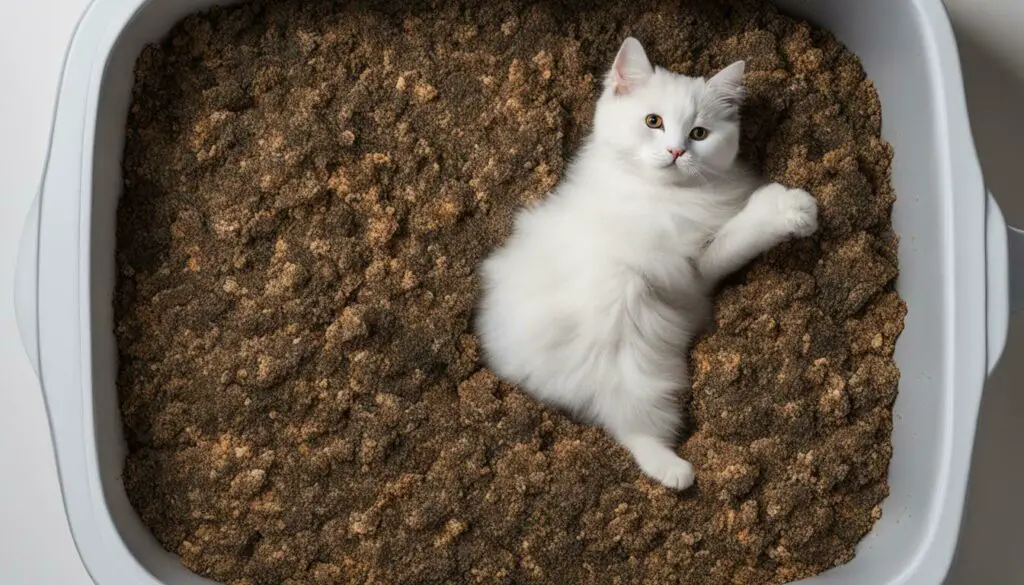
Clumping Litter Maintenance Tips
To ensure your cat’s litter box remains clean and odor-free between litter changes, here are some helpful maintenance tips:
- Scoop the litter box at least once or twice a day to remove solid waste and clumps. This will help prevent odor buildup and maintain hygiene.
- Top up the litter as needed to maintain an appropriate depth. Keep in mind that clumping litter requires a sufficient amount to form solid clumps.
- Clean the litter box thoroughly each time you change the litter. Use mild soap or detergent to wash the box, and rinse it thoroughly to remove any residue. Ensure the box is completely dry before adding fresh litter.
- Consider using a litter mat or tray beneath the litter box for easy cleanup and to catch any loose litter that may get tracked around the house.
By following these tips and replacing clumping litter at the appropriate intervals, you can provide your cat with a clean, comfortable, and inviting litter box environment.
Clumping Litter Maintenance Tips
While clumping litter requires less frequent replacement, proper maintenance is still crucial to ensure a clean and hygienic litter box for your cat. Here are some tips to help you effectively maintain your cat’s litter box when using clumping litter:
- Scoop Daily: Clumping litter forms solid clumps that can be easily removed. To prevent odor and maintain cleanliness, it’s important to scoop the litter box daily. Remove any clumps or solid waste and dispose of them in a regular trash bag. This will help keep the litter box fresh and appealing to your cat.
- Add More Litter: As you scoop out the clumps, you may notice that the litter level decreases. It’s a good idea to add more fresh litter to maintain an adequate depth. This will ensure that your cat has enough litter to dig and cover their waste, reducing the chances of any mess or odor.
- Regularly Clean the Litter Box: While clumping litter does a great job of containing waste, it’s still important to clean the litter box thoroughly. At least once a month, empty the litter box completely and wash it with mild soap or detergent. Rinse it thoroughly to remove any residue before adding fresh litter. This will help prevent the buildup of bacteria and keep the litter box in optimal condition.
To visualize the clumping litter maintenance process, refer to the table below:
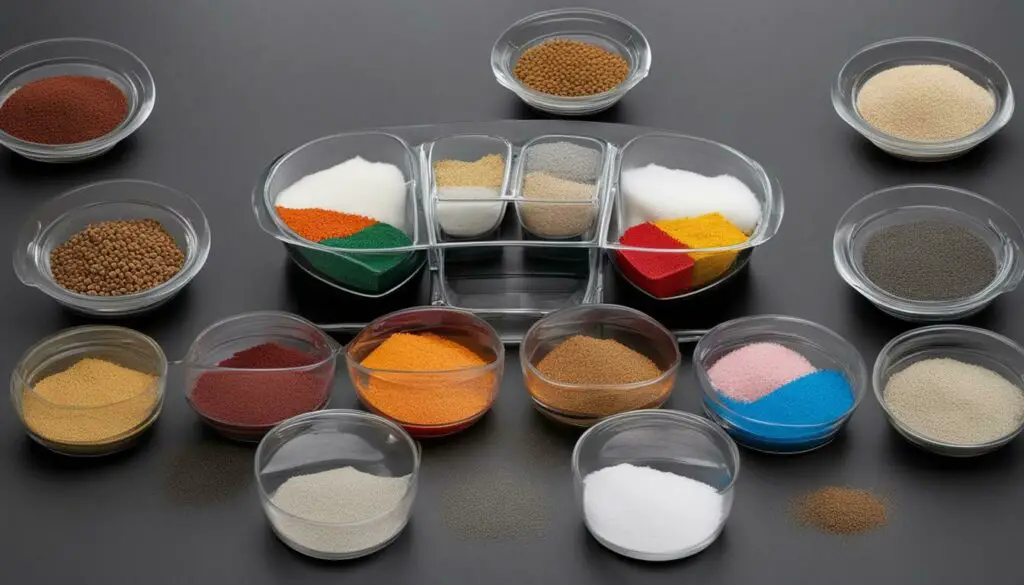
By following these clumping litter maintenance tips, you can ensure a clean and comfortable litter box environment for your cat. Remember, a happy cat starts with a clean litter box!
Thorough Cleaning and Litter Box Preparation
Changing the cat litter goes beyond simply replacing the old litter with fresh one; it involves thorough cleaning and proper preparation of the litter box. Maintaining a clean and odor-free litter box is crucial for the well-being of your cat and the overall cleanliness of your home. Here are some steps you can take to ensure your cat’s litter box is clean and ready for use.
Step 1: Empty and Dispose of Old Litter
Start by emptying the old litter from the box. Use a scoop or a litter box liner to remove the clumps and solid waste. If you’re using non-clumping litter, be sure to remove any soiled areas. Dispose of the used litter in your regular household waste, unless you’re using biodegradable litter, which can be disposed of in communal bio waste. Avoid flushing cat litter down the toilet, as it can cause plumbing issues and environmental damage.
Step 2: Clean the Litter Box
After emptying the old litter, it’s important to thoroughly clean the litter box. Use mild soap or detergent and warm water to scrub the box, ensuring all traces of waste and odor are removed. Rinse the box thoroughly and allow it to air dry completely before adding fresh litter. Avoid using strongly scented cleaning products, as they may be off-putting to your cat.
Step 3: Prepare the Litter Box
Once the litter box is clean and dry, it’s time to prepare it for fresh litter. Add a new layer of litter to the box, ensuring it’s deep enough for your cat to dig and bury waste. The depth of the litter should be approximately 2-3 inches. Be sure to choose a litter that is suitable for your cat’s preferences and needs.
Remember, maintaining a clean litter box is essential for your cat’s comfort and hygiene. By following these steps and regularly changing the litter, you can provide your feline friend with a clean and pleasant environment.
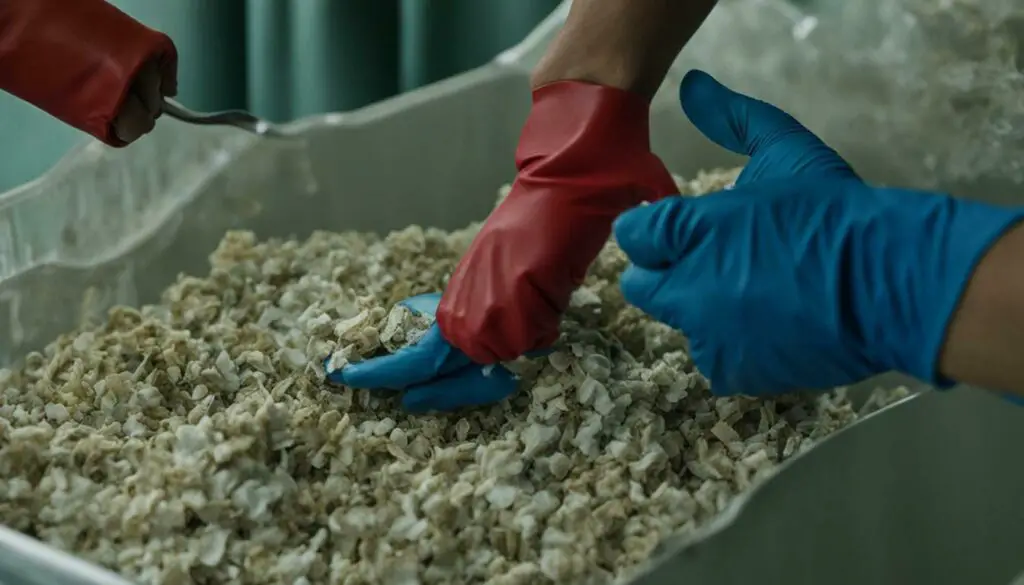
| Benefits of Thorough Litter Box Cleaning | Preventive Measures |
|---|---|
| Reduces the risk of bacterial growth and litter box odor. | Use litter box liners or a scoop for easier waste removal. |
| Prevents the buildup of ammonia, which can be harmful to your cat’s respiratory system. | Consider using litter box deodorizers or baking soda to control odor. |
| Helps maintain your cat’s litter box preferences and encourages regular use. | Avoid overcrowding with too many cats or litter boxes in a limited space. |
Proper Disposal of Cat Litter
When it comes to disposing of cat litter, it’s important to follow the right procedures to protect the environment and prevent any potential health risks. Proper disposal methods depend on the type of litter you use, as not all litters are created equal when it comes to environmental impact.
If you use conventional cat litter that is not biodegradable, it should be disposed of in regular household waste. Double bagging the used litter helps to minimize any potential odor. However, it’s crucial to check your local waste management guidelines, as some areas may have specific regulations for disposing of cat litter.
On the other hand, if you use biodegradable cat litter, you have more eco-friendly disposal options. Biodegradable litter is designed to break down naturally and can be disposed of in communal bio waste or compost. Just make sure to check the packaging or manufacturer’s instructions for specific disposal guidelines.
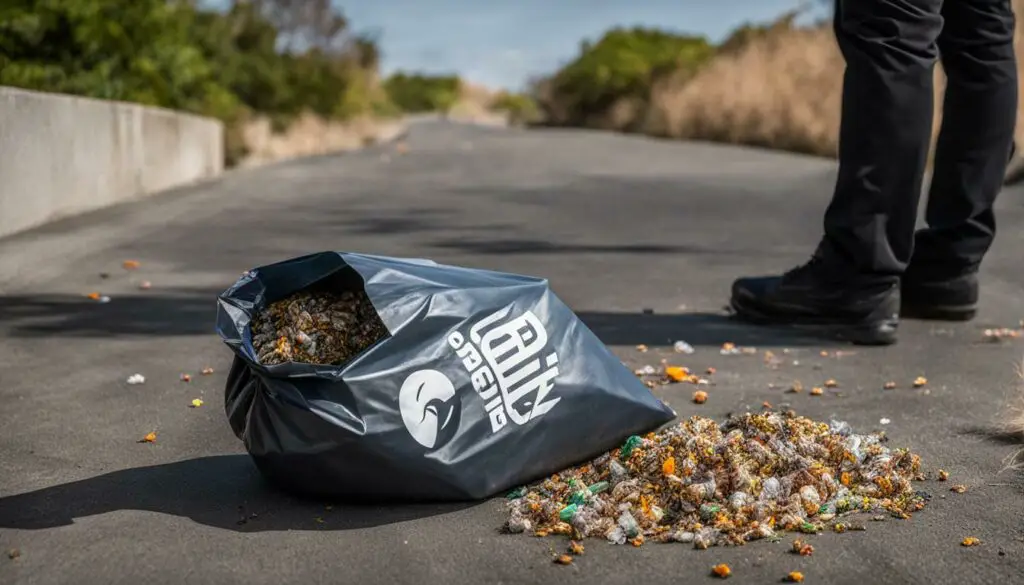
It’s important to note that regardless of the type of litter you use, flushing cat litter down the toilet is not recommended. Cat feces can contain parasites and pathogens that may harm marine life and contaminate water sources. Flushing litter can also cause plumbing issues due to the clumping properties of some litters.
To summarize, proper disposal of cat litter involves following local waste management regulations and considering the type of litter used. Biodegradable litter provides more environmentally friendly disposal options, while conventional litter should be disposed of in regular household waste. By practicing responsible disposal methods, we can protect the environment, our health, and the well-being of our feline friends.
Odor Control Tips
Dealing with litter box odor is a common challenge for cat owners, but with the right approach, you can keep your home fresh and odor-free. Here are some effective tips to control cat litter odor:
- Use a high-quality litter: Choosing the right litter is crucial in preventing odor. Opt for a litter that is specifically designed to control odor, such as those with activated charcoal or baking soda.
- Clean the litter box regularly: Remove solid waste and clumps daily. Cleaning the litter box frequently prevents the buildup of odor-causing bacteria.
- Replace litter as needed: Non-clumping litter should be changed at least once a week, while clumping litter can last up to two weeks. However, if you notice strong odor or the litter appears dirty, it’s time for a change.
- Avoid strongly scented products: While it may be tempting to use strongly scented cleaning products or deodorizers, these can be overwhelming for your cat and may discourage them from using the litter box.
- Proper ventilation: Ensure that the litter box area is well-ventilated to minimize odor buildup. Consider placing the litter box in a well-ventilated area or using a fan to improve air circulation.
- Consider litter box liners: Litter box liners can help make cleaning easier and prevent urine from seeping into the bottom of the litter box, reducing odor.
- Regularly wash the litter box: In addition to changing the litter, it’s important to clean the litter box itself. Use mild soap or detergent to thoroughly clean and disinfect the litter box, removing any lingering odors.
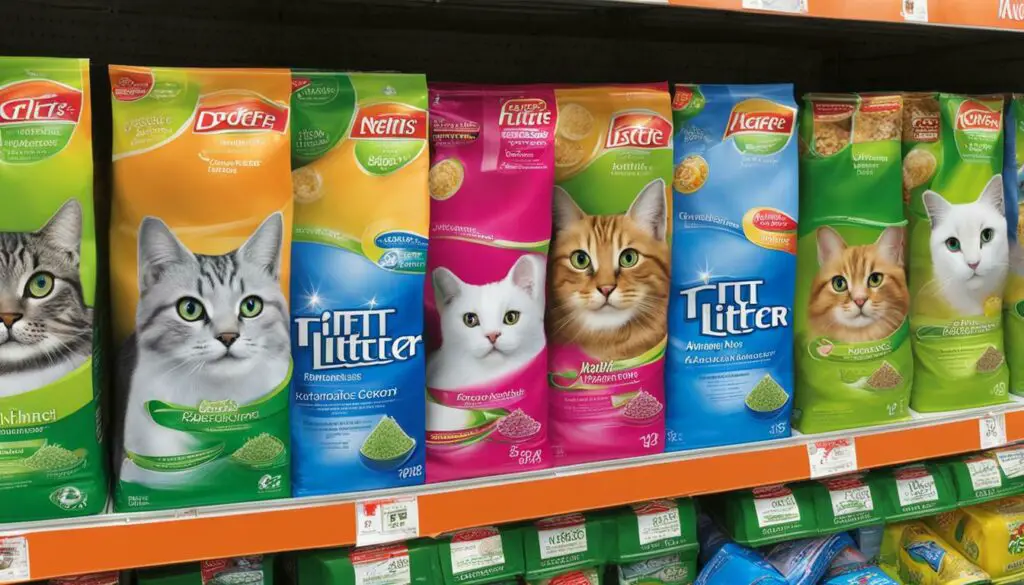
Remember, a clean litter box is essential for your cat’s health and happiness. By following these odor control tips, you can create a pleasant environment for both you and your feline companion.
| Tip | Description |
|---|---|
| Use a high-quality litter | Choose a litter designed to control odor, such as those with activated charcoal or baking soda. |
| Clean the litter box regularly | Remove solid waste and clumps daily to prevent the buildup of odor-causing bacteria. |
| Replace litter as needed | Non-clumping litter should be changed at least once a week, while clumping litter can last up to two weeks. |
| Avoid strongly scented products | Strongly scented cleaning products or deodorizers may discourage your cat from using the litter box. |
| Proper ventilation | Ensure the litter box area is well-ventilated to minimize odor buildup. |
| Consider litter box liners | Liners can make cleaning easier and reduce urine seepage, preventing odor. |
| Regularly wash the litter box | Clean and disinfect the litter box with mild soap or detergent to eliminate lingering odors. |
Avoiding Common Mistakes
Maintaining a clean litter box requires avoiding common mistakes that can lead to unpleasant experiences for both you and your cat. By being aware of these mistakes and taking steps to prevent them, you can ensure a hygienic and comfortable environment for your feline friend.
- Using the wrong litter: Choosing the right type of litter is crucial. Some cats may have preferences for certain textures or scents, so it’s essential to find a litter that your cat is comfortable using. Experiment with different options until you find the one that works best for your cat.
- Not scooping regularly: One of the biggest mistakes cat owners make is not scooping the litter box frequently enough. Ideally, you should scoop the box at least once a day, removing any solid waste. This will help prevent odor buildup and keep the litter box clean.
- Overfilling the litter box: Adding too much litter can make it difficult for your cat to dig and cover their waste. It’s best to follow the recommended litter depth specified by the litter manufacturer. This will ensure your cat has enough space to maneuver comfortably.
- Not cleaning the litter box thoroughly: When changing the litter, it’s important to clean the litter box thoroughly to eliminate any bacteria or odor. Use mild soap or detergent and rinse it well before adding fresh litter. This will create a clean and inviting space for your cat.
“Proper litter box maintenance is essential for your cat’s health and well-being.”
Remember, cats are naturally clean animals, and they prefer a clean litter box. By avoiding these common mistakes and maintaining a clean litter box, you can create a positive and hygienic environment that will keep both you and your cat happy.
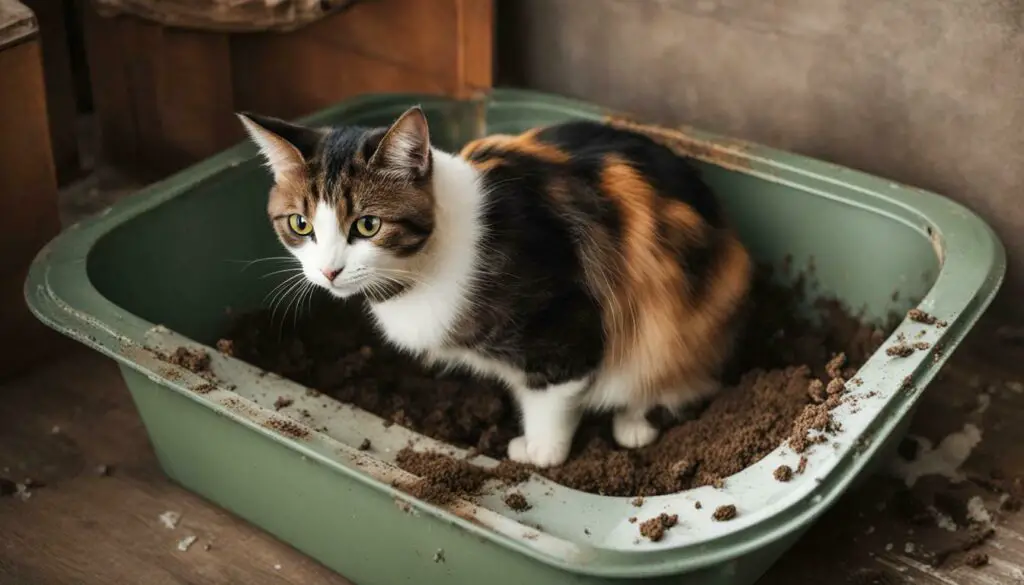
Summary
In summary, maintaining a clean litter box requires avoiding common mistakes such as using the wrong litter, not scooping regularly, overfilling the litter box, and not cleaning it thoroughly. By following these simple guidelines, you can ensure a pleasant and hygienic experience for both you and your cat.
Introducing Cats to New Litter
When introducing your cat to a new type of litter, it’s essential to take a gradual approach to ensure a smooth transition. Cats can be sensitive to changes in their environment, including their litter box. Making the switch too abruptly may cause your cat to reject the new litter or avoid using the litter box altogether. By following a few simple steps, you can help your cat adapt to the new litter with ease.
Start by mixing a small amount of the new litter with their existing litter. This allows your cat to become familiar with the scent and texture of the new litter while still having the comfort of their usual litter. Gradually increase the amount of new litter over the course of several days until you have fully transitioned to the new litter.
Observe your cat during this transition period to ensure they are using the litter box without hesitation. If you notice any signs of discomfort or avoidance, it may be necessary to slow down the transition process or consider trying a different type of litter that is more similar to their previous one. Each cat is unique, so it’s important to be patient and adjust the transition to suit their individual preferences.
| Transition Steps | Timeline |
|---|---|
| Mix small amount of new litter with existing litter | Days 1-2 |
| Gradually increase the amount of new litter | Days 3-5 |
| Monitor cat’s response and adjust as needed | Ongoing |
“Taking a gradual approach when introducing your cat to new litter is key. By giving them time to adjust and slowly transitioning, you can minimize any stress or discomfort they may experience.” – Dr. Jane Smith, Feline Behavior Specialist
Remember, a smooth transition to new litter is important for your cat’s overall litter box usage and satisfaction. By following these steps and being patient, you can ensure a successful introduction to the new litter and maintain a happy and healthy litter box environment for your feline friend.
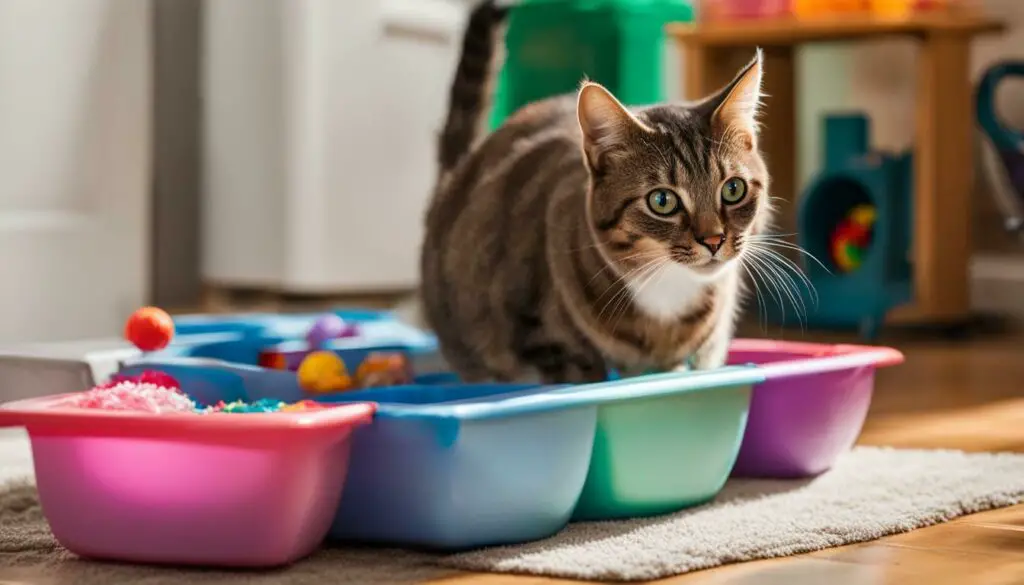
Considerations for Multi-Cat households
If you have multiple cats, it’s important to understand the unique challenges and considerations when it comes to cat litter maintenance. With each additional cat, the frequency of litter changes may need to be increased, as more cats mean more waste. Additionally, cats can be territorial creatures, and having multiple cats sharing the same litter box can lead to stress, anxiety, and potential litter box problems if not managed properly.
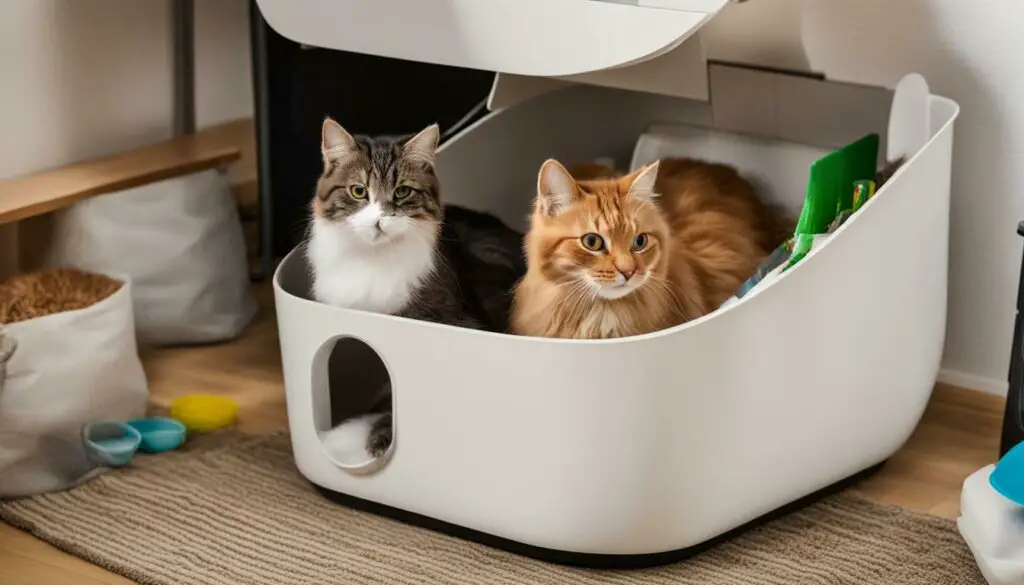
One important consideration for multi-cat households is providing enough litter box space. The general rule of thumb is to have one litter box per cat, plus one extra. This ensures that each cat has enough litter box options to feel comfortable and reduces the chances of litter box conflicts. It’s also important to place the litter boxes in separate areas of the house to provide privacy for each cat.
Another consideration is the type of litter you choose. Clumping litter is generally recommended for multi-cat households because it forms solid clumps that are easier to remove, reducing odor and making it easier to maintain cleanliness. However, some cats may prefer non-clumping litter, so it’s essential to observe your cats’ preferences and choose a litter that works for them.
| Number of Cats | Non-Clumping Litter | Clumping Litter |
|---|---|---|
| 1 | Weekly | Bi-weekly |
| 2 | Every 3-4 days | Weekly |
| 3+ | Every 2-3 days | Every 5-7 days |
Regular cleaning and scooping of the litter boxes are essential in multi-cat households to maintain a clean and odor-free environment. Try to establish a routine where you scoop the litter boxes at least once or twice a day. Also, consider using odor-control products or litter additives specifically designed for multi-cat households to help manage any lingering odors.
Remember, a clean litter box is key to maintaining a happy and healthy environment for all your feline friends.
Choosing the Right Cat Litter
Choosing the right cat litter is an important decision that can affect your cat’s comfort, hygiene, and litter box maintenance. With a variety of options available, it’s essential to consider your cat’s preferences, your household environment, and your own personal priorities. Let’s explore the different types of cat litter and their benefits.
Clumping Litter
Clumping litter is a popular choice for many cat owners due to its convenience and ease of use. This type of litter forms solid clumps when in contact with liquid waste, making it easy to scoop and remove. It helps to control odor and keeps the litter box cleaner for longer periods of time. Clumping litter is typically made from a variety of materials, including clay, silica gel, or plant-based ingredients.
Non-Clumping Litter
Non-clumping litter, also known as traditional or absorbent litter, is another option to consider. This type of litter absorbs urine but does not form clumps. Non-clumping litter is usually made from clay or recycled paper pellets. While it may require more frequent changing compared to clumping litter, it can still provide effective odor control and is often more budget-friendly.

Alternative Litters
In addition to clumping and non-clumping litter, there are alternative options available on the market. These include crystal-based litter, which is highly absorbent and long-lasting, as well as natural and eco-friendly options such as pine or wheat-based litter. These alternatives can be beneficial for cats with sensitivities or for environmentally conscious pet owners.
Consider Your Cat’s Needs
When choosing the right cat litter, it’s important to consider your cat’s individual needs. Some cats may have preferences for certain textures or scents, while others may be more sensitive to dust or allergens. It may be necessary to experiment with different types of litter to find the one that works best for your feline friend. Additionally, consider any health issues your cat may have, such as respiratory problems, as certain litters may aggravate these conditions.
By taking into account your cat’s needs, your own preferences, and the litter’s performance, you can make an informed decision that promotes a clean and comfortable litter box environment. Remember to monitor your cat’s behavior and make adjustments if necessary. A happy and contented cat starts with the right cat litter!
Maintaining a Clean and Happy Environment for Your Cat
Proper cat litter maintenance plays a crucial role in creating a clean and happy environment for your beloved feline friend. By following a few simple steps, you can ensure that your cat’s litter box remains fresh and odor-free, providing them with a comfortable space to do their business.
First and foremost, it’s important to clean the litter box regularly. This means scooping out solid waste daily and removing any clumps in clumping litter. For non-clumping litter, the litter should be completely replaced at least once a week. Use a mild soap or detergent to thoroughly clean the litter box each time you change the litter, ensuring you remove any lingering odors.
In addition to regular cleaning, it’s essential to choose the right type of litter for your cat. Some cats may be sensitive to strongly scented litters, so opt for unscented options if your cat shows any signs of discomfort. It’s also worth considering your cat’s preferences when it comes to litter texture. Some cats prefer finer granules, while others may prefer a coarser texture.
When it comes to disposal, it’s best to dispose of cat litter in regular household waste unless you’re using biodegradable litter, which can be disposed of in communal bio waste. It’s important to note that flushing cat litter down the toilet is not recommended, as it can cause plumbing issues and environmental concerns.
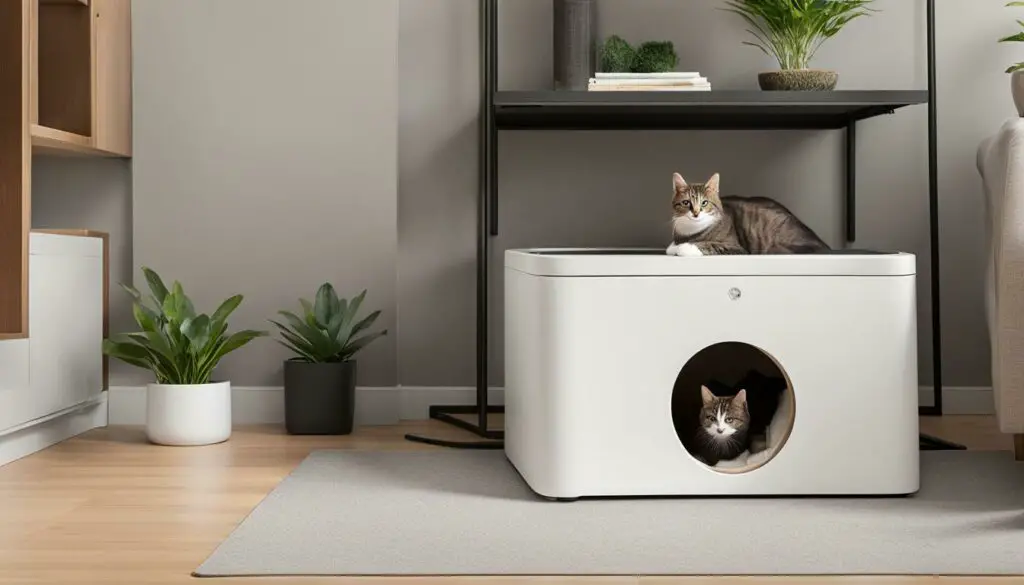
Quick Tips for Maintaining a Clean Litter Box:
- Choose the right litter for your cat’s preferences and sensitivities.
- Scoop the litter box daily to remove solid waste.
- Thoroughly clean the litter box and replace the litter at least once a week.
- Avoid using strongly scented cleaning products or deodorizers, as they may be off-putting to your cat.
- Ensure your cat has easy access to the litter box and that it’s placed in a quiet and private location.
By following these simple guidelines, you can create a clean and happy environment for your cat, ensuring their litter box remains a pleasant and comfortable space. Remember, a clean litter box is not only beneficial for your cat’s well-being, but it also helps maintain a fresh and odor-free home for you and your family.
Conclusion
In conclusion, maintaining a clean litter box is essential for the overall well-being and happiness of your cat. The frequency at which you should change your cat litter depends on several factors, including the type of litter, the number of cats, and the number of litter trays.
For non-clumping litter, it is recommended to change the litter at least once a week for one cat. If you have multiple cats, it may be necessary to change the litter more frequently to prevent odor buildup. On the other hand, clumping litter can be changed less often, typically every two weeks for one cat.
When changing the litter, it is important to thoroughly clean the litter box using mild soap or detergent. This helps to remove any lingering odors and bacteria that may be present. Proper disposal of cat litter is also crucial. Most cat litter can be disposed of in regular household waste, unless you are using biodegradable litter, which can be disposed of in communal bio waste. Avoid flushing cat litter down the toilet, as this can cause plumbing issues and environmental concerns.
To prevent odor and maintain a fresh environment, it is important to keep the litter box clean. Regular scooping and cleaning of the litter box will help to minimize odors and provide a pleasant space for your cat. Avoid using strongly scented cleaning products, deodorizers, or litter types that may be off-putting to your cat, as these can deter them from using the litter box.
By following these guidelines and considering your cat’s unique needs, you can create a clean and comfortable litter box environment that promotes their overall well-being and happiness. Remember, a happy cat starts with a clean litter box!
FAQ
How often should I change non-clumping litter?
Non-clumping litter should be changed at least once a week for one cat. If you have multiple cats, it may need to be changed more frequently.
How often should I change clumping litter?
Clumping litter can be changed less often, about every two weeks for one cat. However, if you notice any odor or if the litter box becomes dirty before that time, it’s best to change it sooner.
How should I clean the litter box when changing the litter?
When changing the litter, it’s important to clean the litter box thoroughly. Use mild soap or detergent and rinse it well before adding fresh litter.
How should I dispose of cat litter?
Cat litter should be disposed of in regular household waste, unless you are using biodegradable litter which can be disposed of in communal bio waste. Avoid flushing litter down the toilet.
How can I prevent odor in the litter box?
To prevent odor, keep the litter box clean by scooping waste daily and changing the litter regularly. Avoid using strongly scented cleaning products, deodorizers, or litter types that may be off-putting to cats.
Source Links
- https://cats.com/how-often-should-you-change-cat-litter
- https://www.purina.co.uk/articles/cats/kitten/behaviour/how-often-to-change-cat-litter
- https://www.catsan.co.uk/cat-litter-tips-and-advice/4-things-you-need-to-know-about-keeping-a-cat-litter-box-clean

